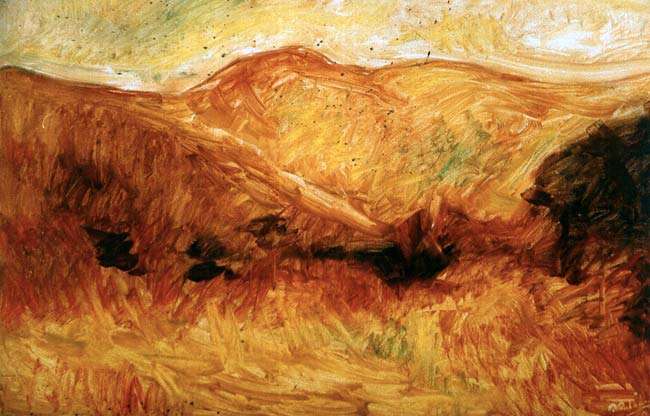José Cláudio
The "Coplas a la muerte de su padre" by Plínio Palhano
It is ideal landscapes seen by someone at full speed as that of a person who slumps into an abyss without time to distinguish the manifold realms of nature. Bloody stains, scratchiness, which could be grass, are the only clues of life, or events linked to it, in this burning atmosphere of waste surfaces giving us the idea they are being violently left behind, testimony of some late awful and unstoppable change at the headquarters of the galaxy. And we can do nothing against it. As if all of a sudden the atmospheric pressure were taken away from us and our bodies blew up, or then the law of gravity, and we were, ignorant of our whereabouts, sucked by the space. This set of pictures could be called "Coplas a la Muerte de su Padre", but without the solace of the Christian faith found in the poem by Jorge Manrique: the eternity here, if that´s the point, is that of the random mineral world, deaf and insensible, which the useless pressure of life has not disturbed, polluted, and even the blood stains maybe are not but optical illusion, despair in search of what has not even existed, and we ourselves perhaps are allucinations of which and of whom we do not know. In these pictures we may find this metaphysical bafflement that reaches, in the larger pictures, what the painter calls "landscapes in whole", his most poignant point. Many times there are remembrances of anthropomorphic or zoomorphic shapes surfaced haphazardly, or found out in our subconscious, unknown by the painter: some believe that such apparitions does not take place by chance, but rather are sorcery, even though the painter was not aware of being a sorcerer. They uncover inner tensions or are shapes which the painter hangs on to, becoming obsessive, reappearing in the pictures in the most different contexts. Mainly in what the painter calls "landscapes in parts", one may find the presence of both his nude pictures and his ox pictures - one of the most expressive exhibitions of the last crop of Pernambucan painters. Now, under the pretext of painting shapes of stones and details of landscapes, the painter makes a review or a style fixation, completely free from figurative concern: it is only figurative because he labels it so, the pictures together show, in fact, a starting point, but stones or whatever are what less matters. It is interesting that for the painter there are still myths long surpassed, like the indecision between figurative and abstract, that moment lived by Cézanne and Van Gogh that Plínio seeks to feel in his flesh, maybe afraid, should he makes up his mind in favor of the abstract painting, of falling in a kind of nihilism. In the painter there is also anxiety, perhaps unconscious, to make modern art, surely for his having a day accepted the academic one, and naively, in a statement that should be published in this catalogue, he boasts of his rebelliousness against the fine arts, as if he lived in the time of Courbet: in the 80s of the XIX century. I am not speaking ironically: I beforehand realize an identification with an idiosyncrasy of a colonized people that, far from debasing him, legitimates him like a sheer model of the Brazilian painting, anthropophagic as Oswald de Andrade called it, which becomes stronger by devouring foreign experiences.
The depuration, the verification of the painter´s own style has reached the top here, and excites our curiosity to know what the painter will do after leaving this frontier behind.
Back to LANDSCAPE IN ITSELF AND IN PARTS




